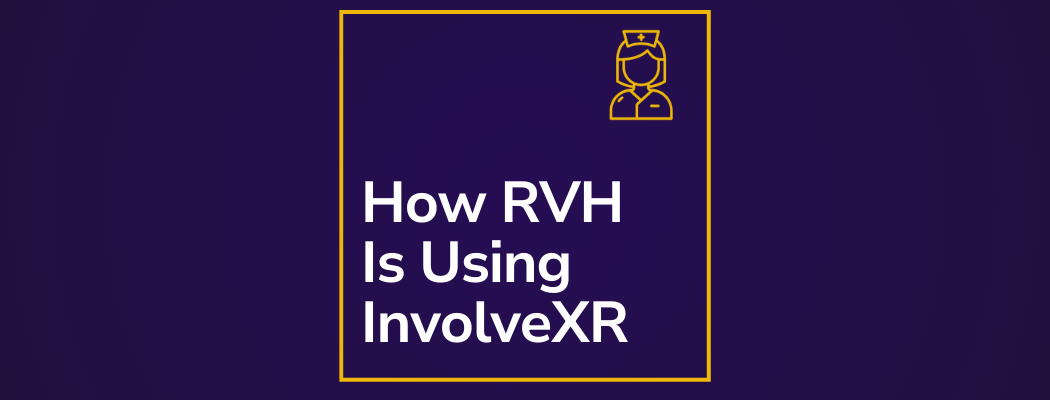
How RVH Is Scaling Stroke Training with InvolveXR
At Lumeto, we’re proud to work with institutions that are leading the charge in healthcare education innovation. One standout example is Royal Victoria Regional Health Centre (RVH) in Barrie, Ontario, where Dr. Matt Moss and Mitchell Greene (Mitch) are leveraging InvolveXR to scale stroke education and reimagine clinical training across the board. Their work offers a compelling glimpse into how VR-based learning is transforming both access and outcomes in clinical education.
How RVH Set the Stage for Scalable Immersive Learning
RVH has been a longtime Lumeto partner and one of the earliest adopters of InvolveXR. But their journey began well before the headset was ever powered on. As Mitchell explained, the initial vision came from Dr. Christopher Martin, who saw VR as a transformative learning modality for the hospital. With some extra support, RVH secured a generous donation to invest in immersive medical education, leading to the recruitment of Dr. Moss as Medical Immersive Education Lead.
This set the stage for an iterative rollout of VR-based training across the organization, guided by a deep commitment to change management. As Mitch put it, “We went from chasing people down the hallway to them coming to us.” That shift didn’t happen overnight, but it marked a major milestone in how immersive training is embraced across departments and clinical levels.

Meeting Challenges with Collaboration and Creativity
Dr. Moss and Mitch were candid about the learning curve they faced, from understanding VR hardware and software, to navigating IT infrastructure and securing stakeholder buy-in. Early efforts included a “VR roadshow” across hospital units to introduce the technology and explore its potential in different clinical contexts. Technical challenges like Wi-Fi instability and managing AI integrations were met with persistence, troubleshooting, and strong internal collaboration, especially with the hospital’s administrative and IT teams. But what got them going was the always positive learner feedback.

A major breakthrough came in optimizing learner onboarding. What began as a 30-minute narrated walkthrough was quickly replaced with interactive in-room demos and concise, hands-on guidance. This focus on accessibility and user experience continues to be a driving force behind RVH’s success.
Why Stroke Training Became a Focal Point
While RVH explored several applications for InvolveXR—including trauma, de-escalation, and ICU training, it was stroke education that became the program’s north star. With increasing numbers of novice nurses entering the workforce, the team identified stroke response as a high-impact training priority.

InvolveXR’s AI-enabled functionality, including voice command and realistic patient behavior, unlocked a new level of clinical realism that simply wasn’t achievable with high-fidelity mannequins. “This was our lightbulb moment,” said Dr. Moss. “You can’t get a mannequin to have facial droop or asymmetric movement. But in VR, you can.”
The team launched a series of stroke-focused med-surg simulations and academic half-days that brought together nurses, residents, and physicians. Learners engaged with a dynamic, evolving case in VR while peers observed remotely, creating opportunities for interdisciplinary learning.
From Internal Wins to Regional Impact
The success of RVH’s stroke simulations didn’t go unnoticed. Recently, the program caught the attention of regional stroke leads, leading to discussions about using InvolveXR as a core component of RVH’s 2027 stroke accreditation. Plans are now underway to expand the program into a research-backed educational initiative that can serve both RVH and surrounding hospitals.

What began as a team effort to introduce a novel technology has evolved into a regional model for scalable, immersive training. One that supports institutional accreditation, clinical excellence, and workforce readiness.
Looking Ahead: Self-Directed Learning and Simulation Lab Expansion
RVH’s next frontier is expanding self-directed learning (SDL). With a new simulation lab in development and growing familiarity among learners, the team envisions a future where residents and staff can drop in and run InvolveXR scenarios independently. Plans are also in motion to develop AI-driven communication training for sensitive conversations like delivering bad news, aligning closely with family medicine certification needs.

Matt and Mitch emphasized the importance of creative freedom and scenario customization in realizing this vision. As Matt shared, “That ability to create and adapt cases is what drew us to Lumeto in the first place.”
Final Thoughts: A Collaborative Journey
It’s not every day you get to see a vision come full circle, from hallway demos to becoming a regional leader in stroke training innovation. What Matt and Mitch have built at RVH is a playbook for how to champion immersive learning in healthcare.
We’re energized by their story, proud to support their journey, and excited for what’s next, not just for RVH, but for every organization reimagining how we train and empower frontline care teams.
Want to explore how your team can do the same?